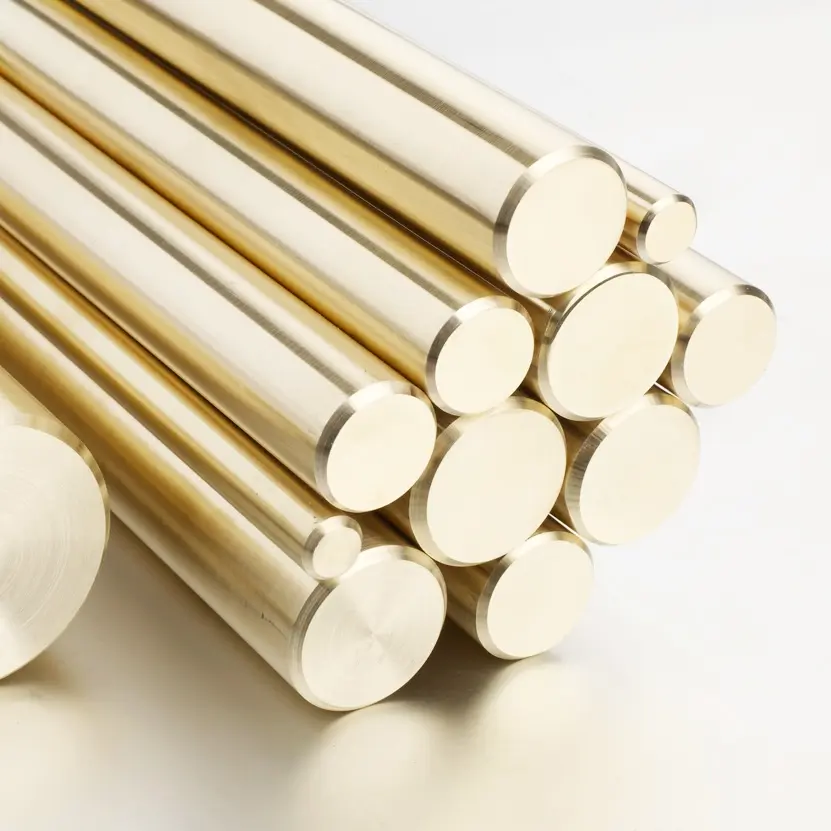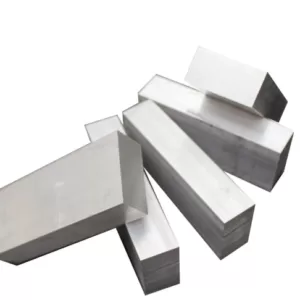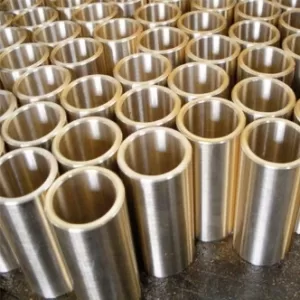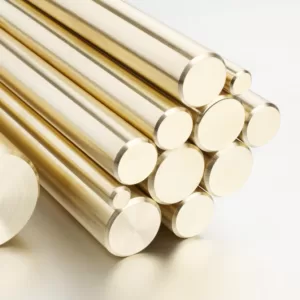Brass is an alloy composed of copper and zinc. Brass made from just copper and zinc is known as ordinary brass. If the alloy includes two or more elements, it is referred to as special brass. Brass is noted for its strong wear resistance and is commonly used to manufacture valves, water pipes, connectors for air conditioning units, and radiators, among other items.
Ordinary brass is a binary alloy of copper and zinc, with a wide range of zinc content, leading to significant differences in its room-temperature microstructure. According to the Cu-Zn binary phase diagram, the microstructure of brass at room temperature can be categorized into three types: brass with a zinc content below 35% consists of a single-phase α solid solution, known as α brass; brass with a zinc content between 36% and 46% consists of a two-phase (α+β) structure, known as (α+β) brass or duplex brass; brass with a zinc content exceeding 46% to 50% consists solely of the β phase, known as β brass.
Main Classifications
Lead Brass
Lead is not soluble in brass and is distributed as free particles along the grain boundaries. Lead brass is categorized into α and (α+β) structures. α lead brass, due to the detrimental effects of lead, has very low hot plasticity, thus it is only processed by cold deformation or hot extrusion. (α+β) lead brass, on the other hand, exhibits good plasticity at high temperatures, allowing for forging
Tin Brass
Adding tin to brass significantly enhances the alloy’s heat resistance, especially its resistance to seawater corrosion, earning tin brass the nickname “naval brass.” Tin dissolves in the copper-based solid solution, strengthening the alloy. However, as the tin content increases, a brittle R phase (CuZnSn compound) may form, adversely affecting the alloy’s ductility, thus tin content in brass is typically kept within 0.5% to 1.5%. Common types of tin brass include HSn70-1, HSn62-1, HSn60-1, etc. The former is an α alloy with high ductility, suitable for both cold and hot pressure processing. The latter two grades have a (α+β) phase structure and often exhibit a small amount of the R phase, showing low room-temperature ductility and are only deformed when heated.
Manganese Brass
Manganese has a high solubility in solid brass. Adding 1% to 4% manganese to brass significantly improves the alloy’s strength and corrosion resistance without compromising its ductility. Manganese brass, typically with a (α+β) structure, includes grades like HMn58-2, which have excellent pressure processing capabilities both in cold and hot states.
Iron Brass
In iron brass, iron precipitates as ferrous-rich particles, acting as nuclei to refine the grains and prevent the growth of recrystallized grains, thereby enhancing the alloy’s mechanical and processing properties. Iron content in iron brass is usually below 1.5%, with a (α+β) structure, offering high strength and toughness, and excellent plasticity at high temperatures, making it deformable even in cold conditions. A common grade is Hfe59-1-1.
Nickel Brass
Nickel forms a continuous solid solution with copper, significantly expanding the α phase region. Adding nickel to brass markedly improves its corrosion resistance in the atmosphere and seawater. Nickel also raises the recrystallization temperature of brass, promoting the formation of finer grains. HNi65-5 nickel brass, with a single-phase α structure, exhibits excellent ductility at room temperature and can also be deformed when heated. However, the content of impurity lead must be strictly controlled to avoid severely deteriorating the alloy’s hot working properties.
Composition and Measurement
The purity of brass can be measured using Archimedes’ principle, determining the volume and mass of a sample, then calculating the proportion of copper in brass based on the densities of copper and zinc.
Ordinary Brass
Brass is an alloy made from copper and zinc. When the zinc content is less than 35%, zinc dissolves in copper to form a single-phase α, known as single-phase brass, which has good ductility and is suitable for both cold and hot pressure processing. When the zinc content ranges from 36% to 46%, the structure includes both the α phase and a copper-zinc β solid solution, referred to as duplex brass. In this case, the β phase decreases the ductility of brass while increasing its tensile strength, making it suitable only for hot pressure processing. Increasing the zinc content further diminishes the tensile strength, rendering the alloy of no practical use.
The designation of brass is indicated by “H” followed by a number, where “H” stands for brass, and the number represents the mass fraction of copper. For example, H68 indicates brass with a copper content of 68% and a zinc content of 32%. For cast brass, a “Z” is added before the code, such as ZH62, with ZCuZn38 indicating cast brass with 38% zinc and the remainder being copper.
H90 and H80 are single-phase brasses, characterized by their golden-yellow color. H59 is a duplex brass, widely used in electrical components such as bolts, nuts, washers, and springs. Generally, single-phase brass is used for cold deformation processes, while duplex brass is utilized for hot deformation processes.
Special Brass
Special brass refers to a multi-element alloy created by adding other alloying elements to ordinary brass. Commonly added elements include lead, tin, and aluminum, resulting in the creation of lead brass, tin brass, and aluminum brass, respectively. The primary purpose of adding these alloying elements is to enhance tensile strength and improve workability.
The designation for special brass follows the format “H + the symbol of the primary added element (excluding zinc) + the mass fraction of copper + the mass fraction of the primary added element + the mass fraction of other elements.” For example, HPb59-1 represents a type of lead brass where the mass fraction of copper is 59%, the mass fraction of the primary added element, lead, is 1%, and the remainder is zinc.
Key Performance Characteristic
Workability Under Pressure
Single-phase alpha brass (ranging from H96 to H65) exhibits excellent ductility and can withstand both cold and hot processing. However, during hot processes like forging, single-phase alpha brass is prone to mid-temperature brittleness, which varies with the amount of zinc present, typically between 200°C and 700°C. Therefore, the processing temperature should exceed 700°C. The cause of mid-temperature brittleness in single-phase alpha brass is mainly due to the presence of ordered compounds Cu3Zn and Cu9Zn within the alpha phase region of the Cu-Zn alloy system. These compounds undergo an ordering transformation at moderate to low temperatures, making the alloy brittle. Additionally, trace amounts of harmful impurities like lead and bismuth, forming low-melting eutectic films at grain boundaries, can cause intergranular cracking during hot working. It has been shown that adding a small amount of cerium effectively eliminates mid-temperature brittleness.
Duplex brass (from H63 to H59) contains a well-documented plastic alpha phase and a beta solid solution based on the electron compound CuZn. The beta phase exhibits high plasticity at elevated temperatures, but its beta prime phase (an ordered solid solution) is hard and brittle at low temperatures. Thus, duplex brass should be forged in a heated state. Brass with a zinc content greater than 46% to 50% is too hard and brittle for pressure processing.
Mechanical Properties
The mechanical properties of brass vary with its zinc content. For alpha brass, as the zinc content increases, both the yield strength (σb) and elongation (δ) continually rise. For duplex brass, the room temperature strength increases with zinc content up to about 45%. Further increasing the zinc content introduces a more brittle r-phase (based on the Cu5Zn8 compound), causing a sharp decrease in strength. The room temperature ductility of duplex brass consistently decreases with increasing zinc content. Therefore, copper-zinc alloys with more than 45% zinc are considered impractical.
Ordinary brass has a wide range of applications, including tank strips, supply and drain pipes, medals, corrugated tubes, serpentine tubes, condenser tubes, shell casings, and various complex-shaped stamped products and small hardware parts. As the zinc content increases from H63 to H59, these alloys can withstand hot processing well and are commonly used in various mechanical and electrical parts, stampings, and musical instruments.
To enhance the corrosion resistance, strength, hardness, and machinability of brass, a small amount (typically 1% to 2%, occasionally up to 3% to 4%, and in rare cases, 5% to 6%) of elements such as tin, aluminum, manganese, iron, silicon, nickel, and lead are added to the copper-zinc alloy. This results in ternary, quaternary, and even quinary alloys, known as complex brass or special brass.
Zinc Equivalent Coefficient
The structure of complex brass can be deduced based on the “zinc equivalent coefficient” of the added elements. Adding a small amount of other alloying elements to the copper-zinc alloy typically shifts the alpha/(alpha+beta) phase boundary in the Cu-Zn phase diagram either to the left or the right. Thus, the structure of special brass is generally equivalent to that of ordinary brass with either increased or decreased zinc content. For example, adding 1% silicon to a Cu-Zn alloy is equivalent to increasing the zinc content by 10% in the alloy. Silicon has the highest “zinc equivalent” value, significantly moving the alpha/(alpha+beta) phase boundary towards the copper side, thereby drastically reducing the alpha phase region. Nickel’s “zinc equivalent coefficient” is negative, meaning it expands the alpha phase region.
The alpha and beta phases in special brass are multi-element complex solid solutions with a significant strengthening effect, whereas in ordinary brass, the alpha and beta phases are simple Cu-Zn solid solutions with a lower strengthening effect. Despite equivalent zinc content, the properties of multi-element solid solutions differ from those of simple binary solid solutions. Thus, minor multi-element strengthening is a method to enhance alloy performance.




